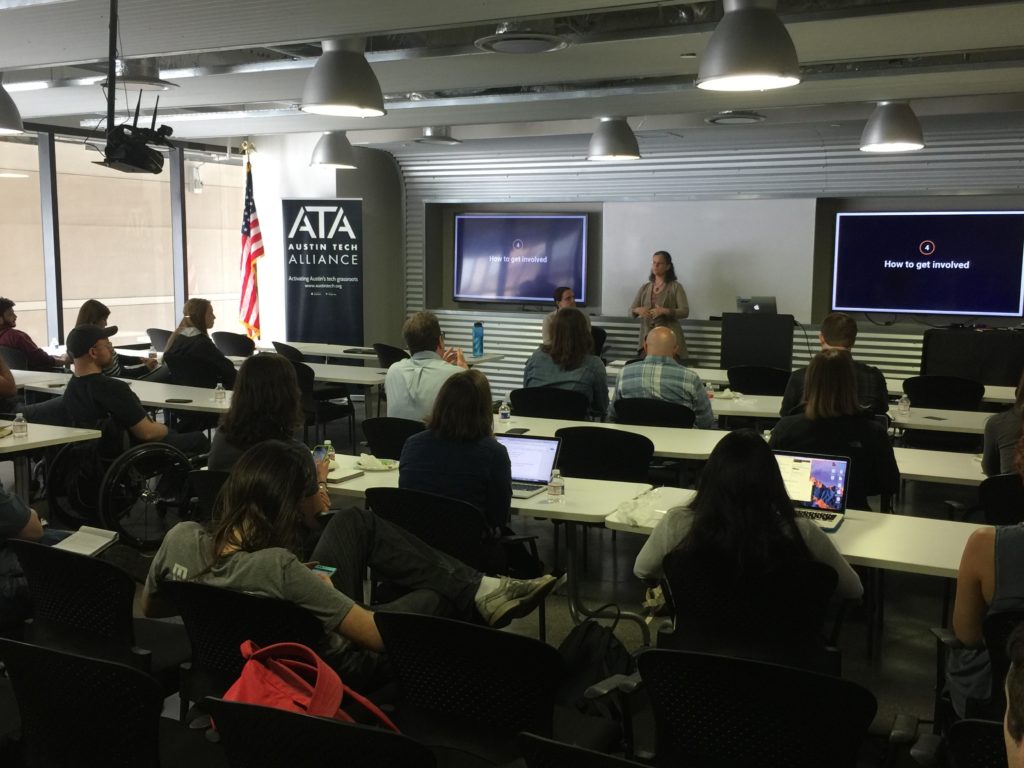On Monday, April 24, Austin Tech Alliance hosted its first lunch-and-learn. Joined by Kerry O’Connor and Ben Guhin from the City of Austin’s Innovation Office, the topic was designing for the 100% — or how user-centered research, design standards, and technology strategy can make services more useful, usable, and accessible for all of us.
The Innovation Office is a relatively new part of the City of Austin, forming in March 2014. The Office focuses on creating diverse and inclusive teams to examine City challenges and opportunities in order to surface better ideas and solutions that make a lasting, positive impact. It works with both internal and external partners to develop, test, organize, and encourage innovative projects with the goal of fostering a culture of innovation within the City of Austin.
More on the speakers:
Kerry O’Connor is Austin’s Chief Innovation Officer, having joined the City of Austin on March 24, 2014. Previously, Kerry worked at the U.S. Department of State, where she established an innovation unit called the Research and Design Center in the Office of the Secretary of State, which offers research, consulting, brainstorming facilitation, and strategic design services. She developed and managed an employee idea generation program, helped architect sustainable management reforms, coordinated logistics for the Pittsburgh G20 Summit, served as an executive staffer, and improved programs and operations at two U.S. Embassies.
Ben Guhin is the City’s Senior Advisor for Design and Technology at the City of Austin, having joined the City on February 22, 2016. He advises the Chief Innovation Officer and Chief Information Officer on how to start a program to bring more designers, developers, and innovation leaders into city government. Previously, he served as a Senior Fellow for UX Design at the Consumer Financial Protection Bureau, and as an interaction designer for education, retail, and entertainment clients including Kaplan, Lowes, and HBO GO.
The event ’s lunch was generously sponsored by Baiti Food, a local catering company that helps to support a number of Austin nonprofits, including Austin Tech Alliance, HealthStart Foundation, and Refugee Services of Texas. The folks at Baiti were extremely responsive and easy to work with, and the food — meatball biryani, baba ghanouj, greek salad, and more — was absolutely delicious. Be sure to visit their website and consider using them for your next catering need.
’s lunch was generously sponsored by Baiti Food, a local catering company that helps to support a number of Austin nonprofits, including Austin Tech Alliance, HealthStart Foundation, and Refugee Services of Texas. The folks at Baiti were extremely responsive and easy to work with, and the food — meatball biryani, baba ghanouj, greek salad, and more — was absolutely delicious. Be sure to visit their website and consider using them for your next catering need.
Three takeaways from the event
Lesson one: don’t just design for you
Instead, design for everyone by designing for inclusion.
According to Kerry, it’s essential to acknowledge the lenses through which each of us view the world. “We tend to pay attention to the things we have experience with … If you want to design for inclusion, you have to expand your scope, do research, and include different people in your testing.”
This is an important lesson as public policy is developed, too. Kerry gave the example of Street Bump, an app created by the City of Boston that uses a smart phone’s accelerometer to collect data on road conditions as users drive on the city’s roads. The goal was to allow Boston to be predictive about what areas of the city needed additional infrastructure investment.
But as Kerry explained, “the people who are digitally savvy … go to certain parts of town. So you are creating systemic inequalities through unconscious biases.”
Lesson two: keep in mind a few high level rules
Both the public and private sectors need to design with accessibility issues as a focus. Ben laid out some common categories:

With that in mind, Ben discussed some basic, high level rules to always keep in mind. Below, view the deck or watch the livestream to get more detail on each of these rules.

Lesson three: accessibility can help you scale
Put another way, your marketshare is your piece of the pie, and accessibility can increase the size of the entire pie.
Kerry talked about the Innovation Office’s work with Austin Resource Recovery, the city department working to transform waste into resources while keeping our community clean.
Austin has a zero waste goal to divert 90% of discarded materials away from landfills by 2040, but it had plateaued in its growth toward that goal. Austin Resource Recovery partnered with the Innovation Office and spent four weeks doing in-home interviews with 52 residents and 3 property managers and owners across the city. The team went into people’s homes and asked them to teach the team about recycling, allowing them to capture key stories and observations.
Those lessons allowed the Innovation Office to rapid prototype and test potential solutions against five behavioral personas:

Given that the folks most in the weeds on recycling policy — including those working for the city and developing the policy — tend to fall into the “Enthusiast” persona, purposefully approaching the problem by viewing possible solutions through different lenses allowed the team to incorporate accessibility as a driving value.
Learn more
You can check out the Design, Technology, and Innovation Fellows on Medium at civiqueso, read about their projects on github, and learn more about becoming a Design, Technology, and Innovation Fellow on the Innovation Office’s site.
Finally, here’s Kerry and Ben’s slide deck, and here’s the livestream:

